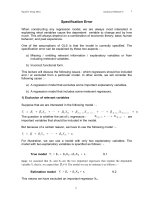Tài liệu Understanding stocks docx
Bạn đang xem bản rút gọn của tài liệu. Xem và tải ngay bản đầy đủ của tài liệu tại đây (1.31 MB, 210 trang )
UNDERSTANDING
STOCKS
Michael Sincere
10381_Sincere_fm.c 7/18/03 10:59 AM Page i
Copyright © 2004 by The McGraw-Hill Companies, Inc. All rights reserved. Manufactured in the
United States of America. Except as permitted under the United States Copyright Act of 1976, no part
of this publication may be reproduced or distributed in any form or by any means, or stored in a data-
base or retrieval system, without the prior written permission of the publisher.
0-07-143582-4
The material in this eBook also appears in the print version of this title: 0-07-140913-0
All trademarks are trademarks of their respective owners. Rather than put a trademark symbol after
every occurrence of a trademarked name, we use names in an editorial fashion only, and to the benefit
of the trademark owner, with no intention of infringement of the trademark. Where such designations
appear in this book, they have been printed with initial caps.
McGraw-Hill eBooks are available at special quantity discounts to use as premiums and sales pro-
motions, or for use in corporate training programs. For more information, please contact George
Hoare, Special Sales, at or (212) 904-4069.
TERMS OF USE
This is a copyrighted work and The McGraw-Hill Companies, Inc. (“McGraw-Hill”) and its licensors
reserve all rights in and to the work. Use of this work is subject to these terms. Except as permitted
under the Copyright Act of 1976 and the right to store and retrieve one copy of the work, you may not
decompile, disassemble, reverse engineer, reproduce, modify, create derivative works based upon,
transmit, distribute, disseminate, sell, publish or sublicense the work or any part of it without
McGraw-Hill’s prior consent. You may use the work for your own noncommercial and personal use;
any other use of the work is strictly prohibited. Your right to use the work may be terminated if you
fail to comply with these terms.
THE WORK IS PROVIDED “AS IS”. McGRAW-HILL AND ITS LICENSORS MAKE NO GUAR-
ANTEES OR WARRANTIES AS TO THE ACCURACY, ADEQUACY OR COMPLETENESS OF
OR RESULTS TO BE OBTAINED FROM USING THE WORK, INCLUDING ANY INFORMA-
TION THAT CAN BE ACCESSED THROUGH THE WORK VIA HYPERLINK OR OTHERWISE,
AND EXPRESSLY DISCLAIM ANY WARRANTY, EXPRESS OR IMPLIED, INCLUDING BUT
NOT LIMITED TO IMPLIED WARRANTIES OF MERCHANTABILITY OR FITNESS FOR A
PARTICULAR PURPOSE. McGraw-Hill and its licensors do not warrant or guarantee that the func-
tions contained in the work will meet your requirements or that its operation will be uninterrupted or
error free. Neither McGraw-Hill nor its licensors shall be liable to you or anyone else for any inac-
curacy, error or omission, regardless of cause, in the work or for any damages resulting therefrom.
McGraw-Hill has no responsibility for the content of any information accessed through the work.
Under no circumstances shall McGraw-Hill and/or its licensors be liable for any indirect, incidental,
special, punitive, consequential or similar damages that result from the use of or inability to use the
work, even if any of them has been advised of the possibility of such damages. This limitation of lia-
bility shall apply to any claim or cause whatsoever whether such claim or cause arises in contract, tort
or otherwise.
DOI: 10.1036/0071435824
ebook_copyright 8 x 10.qxd 8/27/03 9:29 AM Page 1
Want to learn more?
We hope you enjoy this McGraw-Hill eBook! If you d like
more information about this book, its author, or related books
and websites, please click her
e.
DOI Page 6x9 10/2/02 1:33 PM Page 1
,
Contents
Acknowledgments v
Introduction vii
P
ART
O
NE
WHAT YOU NEED TO KNOW FIRST
1 Welcome to the Stock Market 3
2 Stocks: Not Your Only Investment 19
3 How to Classify Stocks 29
4 Fun Things You Can Do (with Stocks) 37
5 Understanding Stock Prices 49
6 Where to Buy Stocks 55
P
ART
T
WO
MONEY-MAKING STRATEGIES
7 Want to Make Money Slowly?
Try These Investment Strategies 69
8 Want to Make Money Fast?
Try These Trading Strategies 77
10381_Sincere_fm.c 7/18/03 10:59 AM Page iii
For more information about. this title, click here.
Copyright © 2004 by The McGraw-Hill Companies, Inc. Click here for Terms of Use.
P
ART
T
HREE
FINDING STOCKS TO BUY AND SELL
9 It’s Really Fundamental:
Introduction to Fundamental Analysis 89
10 Fundamental Analysis: Tools and Tactics 97
11 Let’s Get Technical:
Introduction to Technical Analysis 107
12 Technical Analysis: Tools and Tactics 131
13 The Psychology of Stocks:
Introduction to Sentiment Analysis 141
P
ART
F
OUR
UNCOMMON ADVICE
14 What Makes Stocks Go Up or Down 149
15 Why Investors Lose Money 157
16 What I Really Think about the Stock Market 171
Index 189
iv
CONTENTS
10381_Sincere_fm.c 7/18/03 10:59 AM Page iv
Acknowledgments
I’d like to give special thanks:
To Stephen Isaacs and Jeffrey Krames at McGraw-Hill for once
again giving me the opportunity to do what I love most, and to Pattie
Amoroso for helping me put the pieces together to produce a book.
To my researcher, Maria Schmidt, who found the answer to nearly
everything I asked; Tine Claes, who never fails to find something that
needs improvement; and Lois Sincere, who has truly mastered the idio-
syncrasies of the English language.
To Tom Reid, a teacher at Deerfield High School in Florida, for help-
ing to make the most complicated financial concepts seem easy; student
Bailey Brooks for helping with editing; Dan Larkin, CEO and senior
consultant for Larkin Industries, Inc., for his extremely insightful sug-
gestions and comments; Mike Fredericks, Brad Northern, and Howard
Kornstein for their thoughtful financial analysis and insights; Colleen
McCluney for her encouragement and patience; and Oksana Smirnova
for her inspiration and enthusiasm.
To the hardworking and friendly staff at Barnes & Noble bookstore
and Starbucks in Boca Raton, Florida.
Finally, to my friends, family, and acquaintances:
Idil Baran, Krista Barth, Bruce Berger, Andrew Brownsword,
Sylvia Coppersmith, Lourdes Fernandez-Vidal, Alice Fibigrova, Joe
Harwood, Jackie Krasner, Johan Nilsson, Joanne Pessin, Hal Plotkin,
Anna Ridolfo, Tim Schenden, Tina Siegismund, Luigi Silverstri, Alex
Sincere, Debra Sincere, Miriam Sincere, Richard Sincere, Harvey
10381_Sincere_fm.c 7/18/03 10:59 AM Page v
Copyright © 2004 by The McGraw-Hill Companies, Inc. Click here for Terms of Use.
Small, Bob Spector, Lucie Stejskalova, Deron Wagner, and Kerstin
Woldorf.
For additional reading, I recommend the following books:
The Stock Market Course (John Wiley & Sons, 2001), by George
Fontanills and Tom Gentile
A Beginner’s Guide to Short-Term Trading (Adams Media Corpo-
ration, 2002), by Toni Turner
Reminiscences of a Stock Operator (John Wiley & Sons, 1994), by
Edward Lefevre
vi
ACKNOWLEDGMENTS
10381_Sincere_fm.c 7/18/03 10:59 AM Page vi
Introduction
This book will be different.
Thousands of books have already been written about the stock mar-
ket, many of them technical and tedious. Before I wrote this book, I was
amazed that so many boring books had been written about such a fas-
cinating subject. Just like you, I hate reading books that put me to sleep
by the second chapter. That is why I was so determined to write an
entertaining, easy-to-read, and educational book about the market.
I wanted to write a book that I can hand to you and say, “Read
everything in this book if you want to learn quickly about stocks.” You
don’t have to be a dummy, idiot, or fool to understand the market. You
also don’t have to be a genius. After you read this book, you will real-
ize that understanding stocks is not that hard. (The hard part is making
money, but we’ll get to that later.)
I also don’t think you should have to wade through 300 pages to
learn about the market. Too many books on stocks are as thick as col-
lege textbooks and not nearly as exciting. Even though this book is
short, it is packed with information about investing and trading. I did
my best to make sure that you would have a short and easy read.
I wrote this book because I wanted you to know the truth.
As I was writing, a corporate crime wave was sweeping across
America. Dozens of corporations were accused of cheating people out
of millions of dollars. It upset me that so many investors have become
victims of the stock market. It seems as if the name of the game is entic-
10381_Sincere_fm.c 7/18/03 10:59 AM Page vii
Copyright © 2004 by The McGraw-Hill Companies, Inc. Click here for Terms of Use.
ing individual investors into the market so that they can be duped out of
all their money.
The insiders on Wall Street and in many corporations understand
the rules and know how to use them to lure you into putting your money
in the market. In this book, I promise to tell you the truth about how the
markets operate. Without that knowledge, you hardly have a chance to
win against the pros who do business on Wall Street. They go to work
every day with one goal in mind: to take money away from you.
Because the stock market is a brutal game that is often rigged in
favor of the house, you should be quite sure you know what you’re up
against before you invest your first dime. Unfortunately, you can’t win
unless you know how to play. One goal of this book is to educate you
about how the markets operate so that you can decide for yourself
whether you want to participate. By the end of the book, you’ll know
the players, the rules, and the vocabulary.
I don’t want to scare you, just prepare you.
After my unsettling introduction, you may decide that you don’t
want to have anything to do with the stock market. In my opinion, that
would be a mistake. First of all, understanding the market can help you
make financial decisions. The stock market is the core of our financial
system, and understanding how it works will guide you for the rest of
your life. In addition, the market often acts as a crystal ball, showing
where the economy is headed.
This book is also ideal for people who still aren’t sure whether to
participate in the market. By the last chapter, you should have a better
idea as to whether investing directly in the stock market makes sense
for you. Although I can’t make any promises, it is also possible that
understanding the market will help you build wealth. Perhaps you will
put your money into the stock market, but I will give you other invest-
ment ideas.
How to Read this Book
If you are a first-time investor (and even if you’re not), I suggest you
begin by reading the first, second, and fourth sections. This will give
you an overview of the market (Parts One and Two), and ways to avoid
viii
INTRODUCTION
10381_Sincere_fm.c 7/18/03 10:59 AM Page viii
losing money (Part Four). Because Part Three is the most challenging
and technical, it should be saved for last. As a special bonus, at the end
of the last chapter I reveal a trading strategy that has not lost money
during the last eight calendar years. I think you’ll be intrigued by this
simple but effective strategy that contradicts the advice included in
nearly every other investment book.
I wish you the best of luck. I sincerely hope you find that learning
about stocks is an enlightening experience, one that you will always
remember.
INTRODUCTION
ix
10381_Sincere_fm.c 7/18/03 10:59 AM Page ix
This page intentionally left blank.
PART ONE
WHAT YOU NEED
TO KNOW FIRST
10381_Sincere_01.c 7/18/03 10:57 AM Page 1
Copyright © 2004 by The McGraw-Hill Companies, Inc. Click here for Terms of Use.
This page intentionally left blank.
1
3
Welcome to the
Stock Market
You may be surprised, but the market is not as difficult to understand as
you might think. By the time you finish reading this chapter, you
should have enough knowledge of the market to allow you to sail
through the rest of the book. The trick is to learn about the market in
small steps, which is exactly how I present the information to you.
The Stock Market: The Biggest Auction in the World
Think of the stock market as a huge auction or swap meet (some might
call it a flea market) where people buy and sell pieces of paper called
stock. On one side, you have the owners of corporations who are look-
ing for a convenient way to raise money so that they can hire more
employees, build more factories or offices, and upgrade their equip-
ment. The way they raise money is by issuing shares of stock in their
corporation. On the other side, you have people like you and me who
buy shares of stock in these corporations. The place where we all meet,
the buyers and sellers, is the stock market.
CHAPTER
10381_Sincere_01.c 7/18/03 10:57 AM Page 3
Copyright © 2004 by The McGraw-Hill Companies, Inc. Click here for Terms of Use.
What Is a Share of Stock?
We’re not talking about livestock! Actually, the word stock originally
did come from the word livestock. Instead of trading cows and sheep,
however, we trade pieces of paper that represent ownership—shares—
in a corporation. You may also hear people refer to stocks as equities or
securities. Most people just call them stocks, which means supply.
(After all, the entire stock market is based on the economic theory of
supply and demand.)
When you buy shares of stock in a corporation, you are com-
monly referred to as an investor or a shareholder. When you own a
share of stock, you are sharing in the success of the business, and you
actually become a part owner of the corporation. When you buy a
stock, you get one vote for each share of stock you own. The more
shares you own, therefore, the more of the corporation you control.
Most shareholders own a tiny sliver of the corporation, with little
control over how the corporation is run and no ability to boss anyone
in the corporation around. You’d have to own millions of shares of
stock to become a primary owner of a corporation whose stock is
publicly traded.
In summary, a corporation issues shares of stock so that it can
attract money. Investors are willing to buy stock in a corporation in
order to receive the opportunity to sell the stock at a higher price. If the
corporation does well, the stock you own will probably go up in price,
and you’ll make money. If the corporation does poorly, the stock you
own will probably go down in price, and you’ll lose money (if you sell,
that is).
Stock Certificates: Fancy-Looking Pieces of Paper
Stock certificates are written proof that you have invested in the cor-
poration. (Some people don’t realize that you invest in companies,
not stocks.) Although some people ask for the stock certificates so
that they can keep them in a safe place, most people let a brokerage
firm hold their stock certificates. It is a lot easier that way. To be
4
U
NDERSTANDING
S
TOCKS
10381_Sincere_01.c 7/18/03 10:57 AM Page 4
technical, there are actually two kinds of stock, common and pre-
ferred. In this book, we will always be talking about common stock,
because that is the only type that most corporations issue to
investors. Remember, not all companies issue stock. A company has
to be what is called a corporation, a legally defined term. Most of the
large companies you have heard of are corporations, and, yes, their
stocks are all traded in the stock market. I’m talking about corpora-
tions like Microsoft, IBM, Disney, General Motors, General Electric,
and McDonald’s.
You Buy Stocks for Only One Reason: To Make Money
The stock market is all about making money. Quite simply, if you buy
stock in a corporation that is doing well and making profits, then the
stock you own should go up in price. (By the way, the profits you make
from a stock are called capital gains, which are the difference between
what you paid for a stock and what you sold it for. If you lose money, it
is called a capital loss.)
You make money in the stock market by buying a stock at one price
and selling it at a higher price. It’s that simple. There is no guarantee, of
course, that you’ll make money. Even the stocks of good corporations
can sometimes go down. If you buy stocks in corporations that do well,
you should be rewarded with a higher stock price. It doesn’t always
work out that way, but that is the risk you take when you participate in
the market.
New York: Where Stock Investing Became Popular
Before there was a place called the stock market, buyers and sellers had
to meet in the street. Sometime around 1790, they met every weekday
under a buttonwood tree in New York. It just happened that the name of
the street where all this took place was Wall Street. (For history buffs,
the buttonwood tree was at 68 Wall Street.)
A lot of people heard what was happening on Wall Street and
WELCOME TO THE STOCK MARKET
5
10381_Sincere_01.c 7/18/03 10:57 AM Page 5
wanted a piece of the action. On some days, as many as 100 shares of
stock were exchanged! (In case you don’t think that’s funny, in today’s
market, billions of shares of stock are exchanged every day.)
It got so crowded in the early days that 24 brokers and merchants
who controlled the trading activities decided to organize what they
were doing. For a fixed commission, they agreed to buy and sell shares
of stock in corporations to the public. They gave themselves a quarter
for each share of stock they traded (today we would call them stock-
brokers). The Buttonwood Agreement, as it was called, was signed in
1792. This was the humble beginning of the New York Stock Exchange
(NYSE).
It wasn’t long before the brokers and merchants moved their
offices to a Wall Street coffee shop. Eventually, they moved indoors
permanently to the New York Stock Exchange Building on Wall Street.
Keep in mind that a stock exchange is simply a place where people go
to buy and sell stocks. It provides an organized marketplace for stocks,
just as a supermarket provides a marketplace for food.
Even after 200 years, the name Wall Street is a symbol for the U.S.
stock exchanges and the financial institutions that do business with
them, no matter what their physical location. If you go to New York,
you’ll see that Wall Street is just a narrow street in the financial district
of Lower Manhattan. Therefore, the stock market, or Wall Street, is
really a convenient way of talking about anyone or anything connected
to our financial markets.
Three Major Stock Exchanges
After the NYSE was formed, there were also brokers trading stocks who
weren’t considered good enough for the New York Stock Exchange.
Traders who couldn’t make it on the NYSE traded on the street curb,
which is why they were called curbside traders. Eventually, these traders
moved indoors and established what later became the American Stock
Exchange (AMEX).
There is also a third major stock exchange, the National Association
of Securities Dealers Automated Quotation System (Nasdaq), which
6
U
NDERSTANDING
S
TOCKS
10381_Sincere_01.c 7/18/03 10:57 AM Page 6
was created in 1971. This was the first electronic stock exchange; it was
hooked together by a network of computers. (Yes, they did have com-
puters back then.)
Competition is good for the stock market. It forces the stock
exchanges to fill your orders faster and more cheaply. After all, they want
your business. There are stock exchanges in nearly every country in the
world, although the U.S. market is the largest. U.S. stock exchanges other
than the three major ones include the Cincinnati Stock Exchange, the
Pacific Stock Exchange, the Boston Stock Exchange, and the Philadel-
phia Stock Exchange (the Philadelphia Stock Exchange is our country’s
oldest organized stock exchange). Other countries with stock exchanges
include England, Germany, Switzerland, France, Holland, Russia, Japan,
China, Sweden, Italy, Brazil, Mexico, Canada, and Australia, to name
only a few.
A few years ago, in order to compete more effectively against the
NYSE, the National Association of Securities Dealers (NASD), which
owns the Nasdaq, and the AMEX merged. Although the two exchanges
are operated separately, the merger allowed them to jointly introduce
new investment products. This is interesting, but it doesn’t really affect
you as an investor. In the end, it doesn’t really matter from which
exchange you buy stocks.
Joining a Stock Exchange
It’s not easy for a corporation to be listed on, or join, a stock exchange
because each exchange has many rules and regulations. It can take
years for a corporation to meet all the requirements and join the
exchange. The stock exchanges list corporations that fit the goals and
philosophy of the particular exchange.
For example, the companies that are listed on the NYSE are some of
the best-known and biggest corporations in the United States—blue-chip
corporations like Wal-Mart, Procter & Gamble, Johnson & Johnson, and
Coca-Cola. The Nasdaq, on the other hand, contains many technology
corporations like Cisco Systems, Intel, and Sun Microsystems. In addi-
tion, stocks that are traded “over the counter” (OTC) are located on the
WELCOME TO THE STOCK MARKET
7
10381_Sincere_01.c 7/18/03 10:57 AM Page 7
Nasdaq. By the way, there are over 5000 stocks traded on the three U.S.
stock exchanges and another 5000 smaller companies traded over the
counter.
Corporations: Convincing People to Buy Their Stock
Once a corporation goes public and allows its stock to be traded, the
trick is to convince investors that the corporation will be profitable.
Corporations do everything in their power to attract money from in-
vestors. Bigger corporations spread the word through print and televi-
sion advertising. Smaller corporations might rely on word of mouth,
emails, or news releases. The more people there are who believe in a
corporation, the more people there will be who will buy its stock, and
the more money the people on Wall Street will make. Now do you
understand why everyone is always saying such good things about the
market? If you’re lucky, you’ll also make a few bucks if you invest in a
profitable corporation.
Now that you have some idea of what happens in the back rooms of
the stock brokerage, I’m going to take you upstairs. First, I will intro-
duce you to the three types of people who participate in the market:
individual investors, traders, and professionals. By the time you finish
this book, you should have a better idea of where you fit in.
Individual Investors
Investors buy stocks in corporations that they believe in and plan to
hold those stocks for the long term (usually a year or longer). Investors
generally choose to ignore the short-term day-to-day price fluctuations
of the market. If all goes according to plan, they find that the value of
their investment has increased over time.
One of the most profitable buy-and-hold investors of our time,
Warren Buffett, likes to say that he is not buying a stock, he is buying a
business. He buys stocks for the best price he can and holds them as
8
U
NDERSTANDING
S
TOCKS
10381_Sincere_01.c 7/18/03 10:57 AM Page 8
long as he can—forever, if possible. (When asked when he sells, Buf-
fett once said, “Never.”)
Keep in mind, however, that Buffett buys stocks in conservative
(some would say boring) corporations like insurance companies and
banks and rarely buys technology stocks. Buffett became a billionaire
using his long-term buy-and-hold investment strategy (a strategy is a
plan that helps you determine what stocks to buy or sell).
Investors who bought shares of stock in Caterpillar (CAT), Lock-
heed Martin (LMT), and Minnesota Mining and Manufacturing
(MMM), for example, saw the value of their investments increase over
time, especially during the latter half of the 1990s. Actually, there was
never a better time to be an investor than during the 1990s. You bought
shares of a corporation you knew and believed in, then sat back and
watched the value of the shares increase by 25, 50, or 100 percent.
(This is as good as it gets for investors!)
Short-Term Traders
Unlike investors, short-term traders don’t care about the long-term
prospects of a corporation. Their goal is to take advantage of the short-
term movements in a stock or the market. This means that they may
buy and then sell a stock within 5 minutes, a few hours, a few days, or
even a week or month on occasion. When you are a trader, you are pri-
marily focused on the price of a stock, not on the business of the cor-
poration.
There are many kinds of short-term traders. Some of you may have
heard the term day trader, which refers to a very aggressive short-term
trader. For example, a day trader might buy a stock at $10 a share with
a plan to sell it at $10.50 or $11, usually within the same day. If the
stock goes down in price, he or she will probably sell it quickly for a
small loss. In other words, day traders buy stocks in the morning and
sell them for a higher price a few minutes or hours later. Generally, they
move all their money back to cash by the end of the day. Keep in mind
that it’s extremely hard to consistently make money as a day trader.
Only a small percentage of people make a living at it.
WELCOME TO THE STOCK MARKET
9
10381_Sincere_01.c 7/18/03 10:57 AM Page 9
Professional Traders
Professional traders use other people’s money (and sometimes their
own) to make investments or trades on behalf of clients. Professionals
include individuals who work for Wall Street brokerages and stock
exchanges, but they also include institutional traders like pension
funds, banks, and mutual fund companies.
There is no doubt that institutional investors that have access to
millions of dollars influence not only individual stocks but the entire
market. Some of these institutions have set up computer programs that
automatically buy or sell stocks when certain prices have been reached.
(On days when the market is up or down hundreds of points, the stock
exchanges limit how much institutional investors can buy or sell.)
If you want to be a professional Wall Street trader, you can also
apply to become a member of one of the exchanges. At current prices,
it will cost you several million dollars to buy a seat on the NYSE, and
all you get for this is the freedom to trade stocks directly on the
exchange floor. (For that kind of money, you’d think they’d let you play
golf and swim! For a few million dollars less, you can trade directly
from the comfort of your own home.) Some people with seats rent them
out to professional traders and thus bring in extra income.
How Wall Street Keeps Score
Wall Street has several ways to keep track of the market. One of the eas-
iest ways to find out how the market is performing each day is to look
at a newspaper, television, or the Internet. Typically, people look at the
Dow Jones Industrial Average (DJIA), the most popular method of
determining whether the market is up or down for the day.
The Dow Jones Industrial Average
In 1884, a reporter named Charles Dow calculated an average of the
closing prices of 12 railroad stocks; this became known as the Dow
10
U
NDERSTANDING
S
TOCKS
10381_Sincere_01.c 7/18/03 10:57 AM Page 10
Jones Transportation Average. His goal was to find a way to measure
how the stock market did each day. He then wrote comments about the
stock market in a four-page daily newspaper called a “flimsie,” which
later became the Wall Street Journal.
A few years later, the company Charles Dow helped start, Dow
Jones, launched the Dow Jones Industrial Average, consisting of 12
industrial stocks. If you know about averages, you know that you basi-
cally add up the prices of the stocks in the index and divide by the num-
ber of stocks to create a daily average. By watching the Dow, you can
get a general idea of how the market is doing. It also gives us clues to
the trend of the market, whether it is going up, down, or sideways. (The
trend is simply the direction in which a stock or market is going.)
The original 12 stocks in the Dow were the biggest and most popu-
lar companies at the end of the nineteenth century—for example, Amer-
ican Tobacco, Distilling and Cattle Feeding, U.S. Leather, and General
Electric, to name a few. Guess which stock still remains in the index? (If
you guessed General Electric, you are right. The other corporations
either went out of business or merged with other corporations.)
By 1928, the Dow Jones Industrial Average was increased to 30
stocks, which is the number of stocks in the index today. (By the way,
this index is sometimes called the Dow 30.) These 30 stocks are a cross
section of the most important sectors in the stock market. (A sector is a
group of companies in the same industry, such as technology, utilities,
or energy.) Over time, the Dow changed from an equal-weighted index
to one in which different stocks have different weights. This means that
stocks with a higher weighting affect the Dow index more than stocks
with a lower weighting. For example, since American Express is
weighted high in today’s market, if this stock is having a bad day and
falls by several points, the Dow could end up down for the day.
It’s easy to find out how the Dow did each day—it’s reported in the
media. Since more than half of the public is invested in the stock mar-
ket, there is a lot of interest in what the Dow does each day.
Therefore, when we talk about the Dow Jones being up or down
each day, we’re really talking about a representative group of 30 stocks,
the Dow 30. Even if the market is down for the day, the stock you own
could be up, or the other way around.
WELCOME TO THE STOCK MARKET
11
10381_Sincere_01.c 7/18/03 10:57 AM Page 11
Other Indexes
Although the Dow (operated by the Wall Street Journal) was the first
index to keep track of stocks, hundreds of other indexes have been cre-
ated to track almost everything from transportation to utilities to tech-
nology stocks. Some sophisticated investors keep an eye on many of
these indexes, but most people watch just three.
The next most popular index (after the Dow) is the Nasdaq Com-
posite Index, which tracks the more than 5000 stocks listed on the Nas-
daq. On television or on the Internet, when you see the Dow listed, you
will almost always see the Nasdaq below it.
The third index that many people watch closely is the S&P 500. If
you guessed that this contains 500 stocks, you are right. These are 500
stocks that Standard & Poor’s Corporation (S&P) has selected to repre-
sent the overall stock market. They are usually the largest stocks and
include a lot of technology stocks. Other popular indexes are the Rus-
sell 2000 index and the Wilshire 5000. You’ll learn later that you can
invest directly in them, since they trade just like stocks.
If you were a professional money manager, your goal each year
would be to beat the major indexes. What does this mean? It means that
if the Dow is up 15 percent this year, you would try to get 15 percent or
more. The bad news is that it’s very hard for people, even professional
investors, to beat the indexes. In 2001, it was reported that 50 percent
of the professional money managers don’t beat the indexes each year.
In 2002, it was reported that only 37 percent of the professional man-
agers beat the indexes.
It’s All About Points
To measure how much you make or lose in the stock market, Wall
Street uses a system of points that represent dollars. For example, if
your stock went from $5 a share to $10 a share, we would say that your
stock went up 5 points. That’s how we keep score on Wall Street, but
accountants and market analysts make it seem a lot more complicated
than it is.
The same type of scoring is done with the major indexes like the
Dow, the Nasdaq, and the S&P 500. If the Dow went from 10,000 to
12
U
NDERSTANDING
S
TOCKS
10381_Sincere_01.c 7/18/03 10:57 AM Page 12









